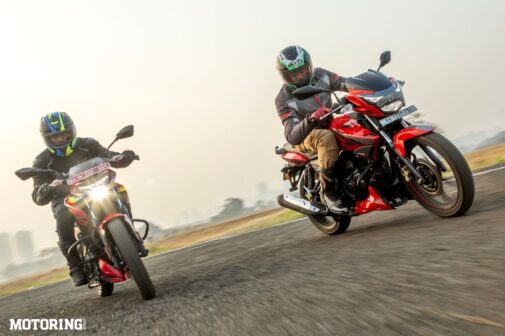The score can never be settled between these two. The TVS Apache and the Bajaj Pulsar have been arch rivals of the highest order ever since they’ve existed. Spot these two bikes at a signal or in traffic, you are bound to witness tension brewing between the two, which leads to a showdown. And this is exactly what was happening between me and Keshav. I am astride the updated TVS Apache RTR 160 2V, while Keshav is all ducked down on the new generation Bajaj Pulsar P150.
The throttles on both the bikes are pinned open, as we make our way through traffic, just to find out who reaches the next intersection first and has the ability to brag about it. I am sure there was a solid temptation within both of us to nudge each other to get ahead. But that wouldn’t be right, now would it? So, to keep matters civilised, we thought it would be perfect to put these two brawlers in the box once again, and see if we could have a winner this time, maybe?
Okay, But Why These Two?
It is an old rivalry, a face-off or a street fight that you just can’t avoid even if you wanted. These two motorcycles were born to execute dominance over anyone who tries to get in their path. And it is just not possible to talk about one without mentioning the other in the same sentence. Both bikes were, and are, close on paper even today. Talk about their displacements or the power figures, they all are strikingly close. Heck, even the difference in their sticker prices is just ` 2000. This is why the only way to settle it is by letting them have a proper go at each other. Both Indian brands, both red.
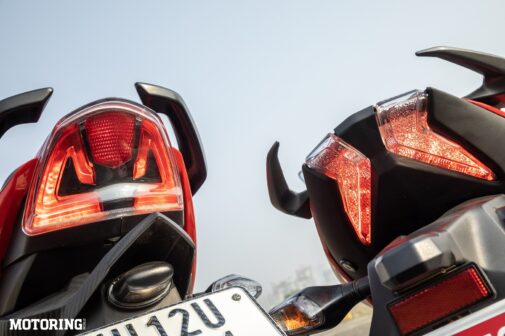
Roads And No Roads
Now, I am sure you must have read up on the standalone stories of both these bikes on these very pages not too long ago. As individuals, both are great motorcycles. The Apache RTR 160 2V is extremely agile, and brisk when it comes to performance. In the hands of a skilled rider, the Apache has the racing credentials that the brand has learned, improvised, and implemented over the years. Also, the Apache RTR 160 2V is the leaner, more frugal version of the RTR 200 4V, which is a good thing. The motorcycle packs a punchy motor and the dynamics are on point. Once you are accustomed to the ergonomics of the motorcycle and proper utilisation of its power band, the motorcycle is an absolute charm to ride.
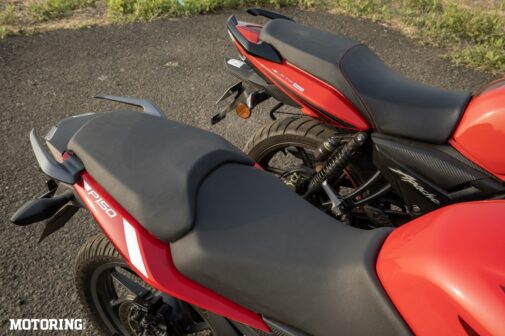
The Bajaj Pulsar P150 is the successor to the Pulsar name — it uses a modern platform and is a proper overhaul. Through the iterations and siblings with different displacements, the Pulsar has lived up nicely to the bad boy image, which has always been the cult factor about this motorcycle. Its imposing stance, with that brash look, has always conveyed dominance on the road. Although, in my opinion, I feel Bajaj has shaved off more than they should have with the P150, as it takes away some of the butch looks that the Pulsar has always been recognised for. But for the compromise, the Pulsar’s form is of a leaner-looking motorcycle, with sculpted lines. The motorcycle has also gained a decent number of tech updates and cool features.
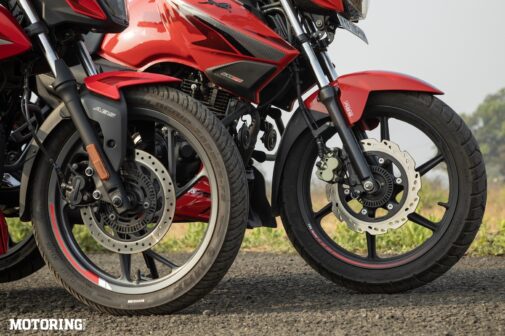
Chomp Away
Let’s look at what these bikes are capable of now after all these years. This is where the two Indian motorcycles lock horns with each other. As both represent reputed brands, let’s not get into a fistfight, right off the bat, but have their numbers do the talking first. Let’s begin with the Pulsar P150. A 150cc single-cylinder mill derived from the new lineage of powertrains is capable of producing 14.29 bhp at the 8500-rpm mark. The torque curve is mainly focused at the low and mid-region of the rev band, which has always been a defining character trait of the Pulsar. The torque figure stands at 1.37 kgm at 6000 rpm. All the power and torque generated is sent to the rear wheel via a slick 5-speed gearbox. The free-revving motor can redline up to 10,000 rpm, but gearshifts for performance and acceleration are best at the 8500-rpm mark.
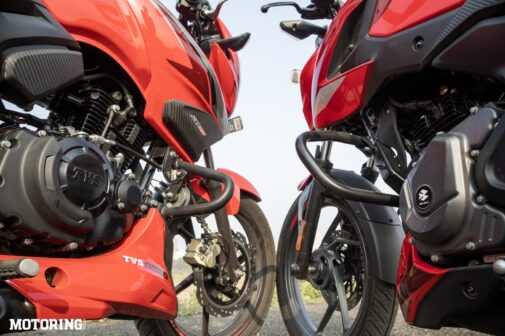
The TVS Apache RTR 160 2V continues to use the same 159.7cc mill, but, over the years, TVS has managed to squeeze the best out of it. With this model, the motor is tuned to produce slightly more power, which is 15.8 bhp at 8750 rpm. Keeping in line with the company’s racing heritage, the powertrain is tuned a few clicks towards performance. This is why the power band is more inclined towards the middle and the top area of the rpm band. Like the Pulsar, the Apache, too, utilises a 5-speed constant mesh gearbox that is precise in shifts, and is also slightly shorter for quicker shifts.
Need For Speed
Coming to the real world, surprisingly, the performance graph of both motorcycles is quite similar. While the Pulsar feels effortless from the get-go, the Apache showcases its engaging nature. The Pulsar, with its lean profile, does seem to be sportier now, but the Apache still manages to pull ahead, thanks to the shorter wheelbase and grippier tyres. A good twist of the right wrist and the Apache is always game to pop the front wheel in the air.
Not that the Pulsar cannot, but it feels more progressive on the P150. Another advantage that the TVS has over here is the ride modes — Urban, Rain, and Sport. While the first two limit the revs to control the power produced, the Sport mode unlocks the full potential of the motorcycle. In terms of top speed, both motorcycles manage to cross the 120-kph mark, but it is just that the Apache does it a little faster.
Turn It Up
Riding dynamics are a crucial factor, and also the reason why naked street bikes exist. And as for these motorcycles, the fight only gets more fierce. While the Apache is already known for its handling attributes, the new Pulsar P150 is completely different from how its predecessors used to perform in this area. The P150 and the RTR 160 2V both have a telescopic fork setup at the front. However, at the rear, the TVS employs a twin shock absorber setup, while the Bajaj comes with a monoshock. After riding the bikes back to back, it was very difficult to pick a winner in this arena. Both bikes lean comfortably into corners, and offer the agility to make quick direction changes. The deciding factor came down to the brakes, where the Apache managed to edge out the Pulsar. The overall bite and feel from the rotor are communicated very effectively. As for the P150, there is a slight wooden feel at the lever, which can be a bit concerning at the time of hard braking.
Who Dares, Wins!
This standoff has been a tough one, and there is no doubt about that. It is quite rare for two motorcycles to breathe down each other’s neck with such intensity and determination. To be honest, the Apache RTR 160 2V and Pulsar P150 are evenly matched, it takes two very different and very conscious riders to make the right decision. The Apache RTR 160 2V’s sporty and engaging character asks for a committed rider, with an inclination to a brisk style of riding. Meanwhile, the Pulsar P150 is a motorcycle that rides brilliantly and has barely any vibrations. It is more inclined to riders who want a mix of performance and comfort. So, to answer the important question, to choose a winner, it comes down to a matter of preference, and depends on how you ride. If you are an experienced rider, the Apache will reward you with more riding pleasure. Meanwhile, if you are new to motorcycling, the Pulsar would be a preferred choice for all that it offers.
MOTODATA
TVS Apache RTR 160 2VPOWERTRAIN
Displacement:
Max Power:
Max Torque:
Transmission:
159.7cc, single
15.8 bhp@8750 rpm
1.41 kgm@7000 rpm
5-speed
CHASSIS
Type: Double cradle frame
BRAKES
F/R: 270-mm disc / 200-mm disc
TYRES
F/R: 90/90 R17 / 120/70 R17
DIMENSIONS
L/W/H (mm):
Wheelbase:
Ground Clearance:
Seat Height:
Kerb Weight:
Fuel Capacity:
2085/730/1105
1300 mm
180 mm
790 mm
138 kg
12 litres
PRICE
Rs 1.21 Lakh (ex-showroom, Delhi)
MOTODATA
Bajaj Pulsar P150POWERTRAIN
Displacement:
Max Power:
Max Torque:
Transmission:
150cc, single
14.29 bhp@8500 rpm
1.37 kgm@6000 rpm
5-speed
CHASSIS
Type: Tubular cradle frame
BRAKES
F/R: 260-mm disc / 230-mm disc
TYRES
F/R: 90/90 R17 / 110/80 R17
DIMENSIONS
L/W/H (mm):
Wheelbase:
Ground Clearance:
Seat Height:
Kerb Weight:
Fuel Capacity:
NA
1352 mm
165 mm
790 mm
141 kg
14 litres
PRICE
Rs 1.19 Lakh (ex-showroom, Delhi)










